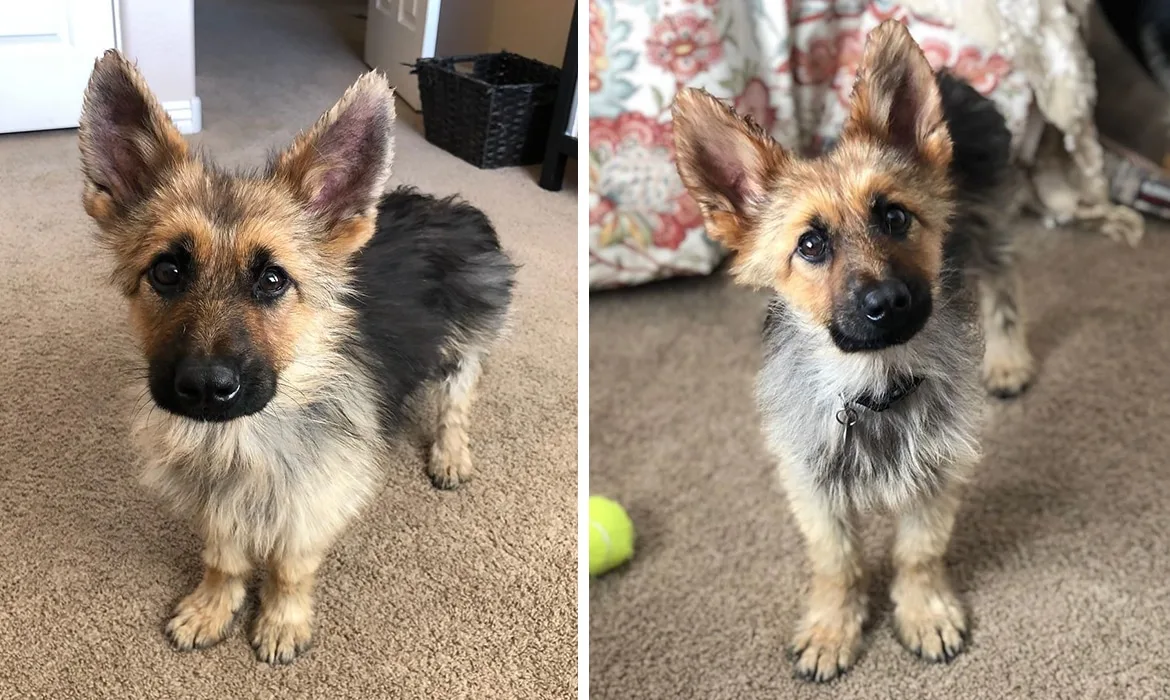Wouldn’t it be nice if our dogs would forever stay puppies? Every dog owner has wished for that at some point. But, at some point, they have to grow up. Now, there is one dog that will forever stay a puppy. Have you heard of Ranger the dwarf German Shepherd? Well, Ranger has a condition that’s called dwarfism. Because of this condition, he’ll forever look like a puppy that is like three months of age.
I’m not kidding! A purebred German Shepherd is usually a large dog, but not this one! But, even though it sounds like a dream come true for many dog owners. This genetic disorder does come with a few complications.
When Ranger was just a puppy he went through a lot. His health was bad. Besides not growing, he also had a thyroid disorder.
His thyroid gland didn’t produce enough hormones. Causing Ranger to have flaky skin and hair loss. But don’t worry. Ranger is now taking medication and is happy and healthy.
Dwarf German Shepherd – Dwarfism
Pituitary Dwarfism is a condition that causes dogs, in this case, German Shepherds, to stay small. They look like puppies their whole life!
But how does it happen? This condition happens when two dogs with the recessive gene that causes dwarfism, are bred together. So, if one parent has the gene, and the other doesn’t. Then the puppy won’t have the condition either.
This condition is possible in other breeds too. For example, Australian Shepherds,
Golden Retrievers, Labrador Retrievers, Basset Hounds, Corgis, and so on.
How dwarfism impacts German Shepherds
So, how does this condition even impact German Shepherd dogs? How is the dwarf German Shepherd like? What happens with them?
Well, in puppyhood the condition isn’t obvious. Dwarfism only becomes apparent when the puppies start growing and developing.
Generally speaking, your vet can tell your dog has Pituitary Dwarfism when they’re three to five months old.
Besides this, there aren’t only physical symptoms. GSDs with this condition can also have problems with their liver and kidneys. Neurological issues are also possible, as well as paralysis.
The pituitary gland is affected too, the hormones it produces are reduced. This leads to thyroid function and hair loss.
Dogs with dwarfism live shorter too. Their life expectancy is around five years. The life expectancy of a healthy GSD is nine to 13 years. So, it’s a big difference.
Those dogs also tend to get sick easily because their immune system is weak.
Possible complications
Dwarfism impacts hormones, like the growth hormone, that are responsible for many vital body functions. So, there are complications and side effects that can happen.
Some of the possible complications are:
- shortened lifespan due to a strain on so many body processes
- back pain and injury due to abnormal distribution of the cervical vertebra
- liver disease and ultimately liver failure
- kidney disease and kidney failure
- skin infections that are slow to heal
- hypothyroidism
Owning a dwarf German Shepherd
We’ve learned a little bit about dwarfism. But, what is it like to own a dog with dwarfism? What is it like to take care of them?
I’ll be honest. It’s not easy with a dog with dwarfism. But, a dwarf German Shepherd can still make a good companion.
Despite the gene, your German Shepherd still has the same characteristics as GSD. They are loyal and smart. They can be trained to do anything.
But, this condition can impact their personality a little bit. They can be a bit more aggressive or have anxiety.
Some puppies can even be a bit slow or dull. Also, your dwarf German Shepherd will probably need supplements, for the rest of its life.
Exercising a dwarf GSD
Your dwarf GSD could be in pain when they play. So you will have to limit their activity. Normally, German Shepherds need at least one hour of exercise a day and a couple of long walks. But that’s not the case with the dwarf.
This condition affects the dog’s spine. So, swimming is a good exercise because it’s great for spinal issues.
But, you shouldn’t overdo that either. Your vet should give you instructions on how much exercise your dog can take. And what exercise you should avoid.
Grooming
Taking care of your dwarf GSD’s coat isn’t easy. As puppies, these dogs will keep their coat longer than other dogs. During the first year their coat will fall out and they will start going bald.
This is when you have to start treating hair loss and skin issues. But their coat will never be as thick as that of the GSD.
During their life, they will continue to lose hair so you might want to get them a sweater, to keep them warm during the winter. Also, don’t forget sunscreen in the summer. They will have some bald spots, you should protect them.
Conclusion
Dwarfism is common in German Shepherds, and there are many breeds where you can find dwarf dogs. In fact, 11% of dogs are carriers of that gene. But, this condition is preventable. Breeders just need to have the parents go through genetic testing before breeding. This way they can make sure that this disorder or any other health issues aren’t passed on.
In my opinion, you shouldn’t get a dwarf German Shepherd. These dogs come with so many problems. And it’s very difficult to deal with them. Dwarfism in German Shepherds is not only a problem for the dogs but for the owners too.
Sure, it’s nice to have a dog that will forever be a puppy, but are you ready for all the health problems? Are you ready for all the complications? Also, it’s a big responsibility.
So, if you want a GSD then get one from a reputable breeder and not German Shepherd puppy mills. Someone who will sell you a healthy dog. If you want a small dog, then consider another breed.

